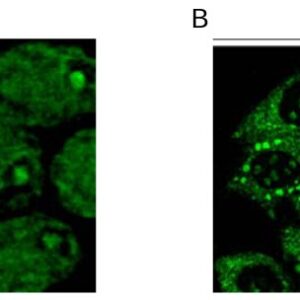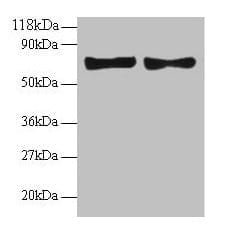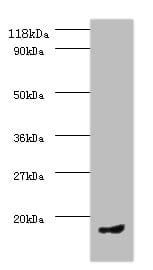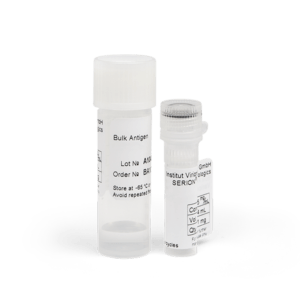| Weight | 1 lbs |
|---|---|
| Dimensions | 9 × 5 × 2 in |
| host | rabbit |
| isotype | IgG |
| clonality | polyclonal |
| concentration | 1 mg/mL |
| applications | ICC/IF, WB |
| reactivity | Bcl-xL (Phospho-Ser62) |
| available sizes | 100 µL |
rabbit anti-Bcl-xL (Phospho-Ser62) polyclonal antibody 9132
$366.00
Antibody summary
- Rabbit polyclonal to Bcl-xL (Phospho-Ser62)
- Suitable for: WB,IHC,IF
- Isotype: Whole IgG
- 100 µl
rabbit anti-Bcl-xL (Phospho-Ser62) polyclonal antibody 9132
| antibody |
|---|
| Tested applications WB,IHC,IHC,ICC/IF |
| Recommended dilutions Immunoblotting: use at dilution of 1:500-1:1,000. A ban of ~30kDa is detected. Immunohistochemistry: use at dilution of 1:50-1:100. Immunofluorescence: use at dilution of 1:100-1:200. These are recommended working dilutions. End user should determine optimal dilutions |
| Immunogen Peptide sequence that includes phosphorylation site of Serine 62 derived from human Bcl-xL and conjugated to KLH. |
| Size and concentration 100µL and 1 mg/mL |
| Form liquid |
| Storage Instructions This antibody is stable for at least one (1) year at -20°C. |
| Storage buffer PBS (without Mg2 and Ca2 ), pH 7.4, 150mM NaCl, |
| Purity affinity purified |
| Clonality polyclonal |
| Isotype IgG |
| Compatible secondaries goat anti-rabbit IgG, H&L chain specific, peroxidase conjugated, conjugated polyclonal antibody 9512 goat anti-rabbit IgG, H&L chain specific, biotin conjugated polyclonal antibody 2079 goat anti-rabbit IgG, H&L chain specific, FITC conjugated polyclonal antibody 7863 goat anti-rabbit IgG, H&L chain specific, Cross Absorbed polyclonal antibody 2371 goat anti-rabbit IgG, H&L chain specific, biotin conjugated polyclonal antibody, crossabsorbed 1715 goat anti-rabbit IgG, H&L chain specific, FITC conjugated polyclonal antibody, crossabsorbed 1720 |
| Isotype control Rabbit polyclonal - Isotype Control |
| target relevance |
|---|
| Protein names Bcl-2-like protein 1 (Bcl2-L-1) (Apoptosis regulator Bcl-X) |
| Gene names BCL2L1,BCL2L1 BCL2L BCLX |
| Protein family Bcl-2 family |
| Mass 26049Da |
| Function FUNCTION: Potent inhibitor of cell death. Inhibits activation of caspases. Appears to regulate cell death by blocking the voltage-dependent anion channel (VDAC) by binding to it and preventing the release of the caspase activator, CYC1, from the mitochondrial membrane. Also acts as a regulator of G2 checkpoint and progression to cytokinesis during mitosis.; FUNCTION: Isoform Bcl-X(L) also regulates presynaptic plasticity, including neurotransmitter release and recovery, number of axonal mitochondria as well as size and number of synaptic vesicle clusters. During synaptic stimulation, increases ATP availability from mitochondria through regulation of mitochondrial membrane ATP synthase F(1)F(0) activity and regulates endocytic vesicle retrieval in hippocampal neurons through association with DMN1L and stimulation of its GTPase activity in synaptic vesicles. May attenuate inflammation impairing NLRP1-inflammasome activation, hence CASP1 activation and IL1B release (PubMed:17418785). {ECO:0000269|PubMed:17418785}.; FUNCTION: Isoform Bcl-X(S) promotes apoptosis. |
| Subellular location SUBCELLULAR LOCATION: [Isoform Bcl-X(L)]: Mitochondrion inner membrane {ECO:0000250}. Mitochondrion outer membrane {ECO:0000250}. Mitochondrion matrix {ECO:0000250}. Cytoplasmic vesicle, secretory vesicle, synaptic vesicle membrane {ECO:0000250}. Cytoplasm, cytosol {ECO:0000250}. Cytoplasm, cytoskeleton, microtubule organizing center, centrosome. Nucleus membrane {ECO:0000250}; Single-pass membrane protein {ECO:0000250}; Cytoplasmic side {ECO:0000250}. Note=After neuronal stimulation, translocates from cytosol to synaptic vesicle and mitochondrion membrane in a calmodulin-dependent manner (By similarity). Localizes to the centrosome when phosphorylated at Ser-49. {ECO:0000250}. |
| Tissues TISSUE SPECIFICITY: Bcl-X(S) is expressed at high levels in cells that undergo a high rate of turnover, such as developing lymphocytes. In contrast, Bcl-X(L) is found in tissues containing long-lived postmitotic cells, such as adult brain. |
| Structure SUBUNIT: Homodimer. Interacts with BCL2L11 (By similarity). Interacts with BAD. Interacts with PGAM5. Interacts with HEBP2. Interacts with p53/TP53 and BBC3; interaction with BBC3 disrupts the interaction with p53/TP53. Interacts with ATP5F1A and ATP5F1B; the interactions mediate the association of isoform Bcl-X(L) with the mitochondrial membrane ATP synthase F(1)F(0) ATP synthase. Interacts with VDAC1 (PubMed:25296756). Interacts with BCL2L11 (via BH3) (PubMed:27013495). Interacts with RNF183 (PubMed:29507230). Interacts with GIMAP3/IAN4 and GIMAP5/IAN5 (PubMed:16509771). Interacts with GIMAP5 and HSPA8/HSC70; the interaction between HSPA8 and BCL2L1 is impaired in the absence of GIMAP5 (By similarity). Interacts with isoform 4 of CLU; this interaction releases and activates BAX and promotes cell death (PubMed:21567405). {ECO:0000250|UniProtKB:P53563, ECO:0000250|UniProtKB:Q64373, ECO:0000269|PubMed:10772918, ECO:0000269|PubMed:11206074, ECO:0000269|PubMed:11463391, ECO:0000269|PubMed:16509771, ECO:0000269|PubMed:17046835, ECO:0000269|PubMed:21567405, ECO:0000269|PubMed:21639858, ECO:0000269|PubMed:23340338, ECO:0000269|PubMed:25296756, ECO:0000269|PubMed:27013495, ECO:0000269|PubMed:29507230, ECO:0000269|PubMed:9675101}.; SUBUNIT: [Isoform Bcl-X(L)]: Forms heterodimers with BAX, BAK or BCL2; heterodimerization with BAX does not seem to be required for anti-apoptotic activity (PubMed:7644501). Interacts with isoform 1 of SIVA1; the interaction inhibits the anti-apoptotic activity (PubMed:12011449). Interacts with IKZF3 (PubMed:11714801). Interacts with RTL10/BOP (PubMed:23055042). Interacts with DNM1L and CLTA; DNM1L and BCL2L1 isoform BCL-X(L) may form a complex in synaptic vesicles that also contains clathrin and MFF (PubMed:23792689). Interacts (via the loop between motifs BH4 and BH3) with NLRP1 (via LRR repeats), but not with NLRP2, NLRP3, NLRP4, PYCARD, nor MEFV (PubMed:17418785). Interacts with BECN1 (PubMed:17337444, PubMed:22498477). {ECO:0000269|PubMed:11714801, ECO:0000269|PubMed:12011449, ECO:0000269|PubMed:17337444, ECO:0000269|PubMed:17418785, ECO:0000269|PubMed:22498477, ECO:0000269|PubMed:23055042, ECO:0000269|PubMed:23792689, ECO:0000269|PubMed:7644501}. |
| Post-translational modification PTM: Proteolytically cleaved by caspases during apoptosis. The cleaved protein, lacking the BH4 motif, has pro-apoptotic activity. {ECO:0000269|PubMed:9435230}.; PTM: Phosphorylated on Ser-62 by CDK1. This phosphorylation is partial in normal mitotic cells, but complete in G2-arrested cells upon DNA-damage, thus promoting subsequent apoptosis probably by triggering caspases-mediated proteolysis. Phosphorylated by PLK3, leading to regulate the G2 checkpoint and progression to cytokinesis during mitosis. Phosphorylation at Ser-49 appears during the S phase and G2, disappears rapidly in early mitosis during prometaphase, metaphase and early anaphase, and re-appears during telophase and cytokinesis. {ECO:0000269|PubMed:19917720, ECO:0000269|PubMed:21840391}.; PTM: Ubiquitinated by RNF183 during prolonged ER stress, leading to degradation by the proteosome. {ECO:0000269|PubMed:29507230}. |
| Domain DOMAIN: The BH4 motif is required for anti-apoptotic activity. The BH1 and BH2 motifs are required for both heterodimerization with other Bcl-2 family members and for repression of cell death.; DOMAIN: The loop between motifs BH4 and BH3 is required for the interaction with NLRP1. {ECO:0000269|PubMed:17418785}. |
| Target Relevance information above includes information from UniProt accession: Q07817 |
| The UniProt Consortium |
Data
| No results found |
Publications
| pmid | title | authors | citation |
|---|---|---|---|
| We haven't added any publications to our database yet. | |||
Protocols
| relevant to this product |
|---|
| Western blot IHC ICC |
Documents
| # | SDS | Certificate | |
|---|---|---|---|
| Please enter your product and batch number here to retrieve product datasheet, SDS, and QC information. | |||
Only logged in customers who have purchased this product may leave a review.








Reviews
There are no reviews yet.